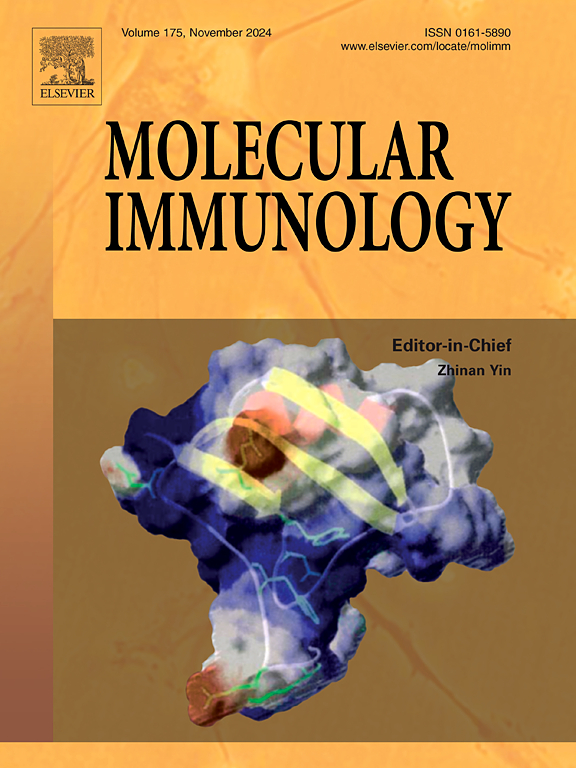Monochromatic green light-mediated melatonin promotes cecal barrier function in broilers
IF 3
3区 医学
Q2 BIOCHEMISTRY & MOLECULAR BIOLOGY
引用次数: 0
Abstract
Light plays a crucial role as an environmental factor, greatly affecting chick behavior, production performance and health. Melatonin, an essential marker of photoelectric signaling, plays a role in regulating various physiological functions in broilers, such as gut health. However, whether monochromatic light can mediate melatonin secretion to regulate intestinal function and its regulatory mechanism are not known. In the present study, we showed that monochromatic green light significantly enhanced the mucosal barrier function of the broiler cecum, including the up-regulation of goblet cells and their secreted MUC2 content, tight junction protein expression and enterocyte proliferative viability. However, when the pineal gland was removed, accompanied by a decrease in melatonin content, the green light advantage disappeared and the intestinal mucosal barrier function was severely impaired. Mechanistically, we found that monochromatic green light promotes melatonin secretion, which enters the intestine to bind Mel1a receptors located on macrophage membranes in cecum, inhibits its downstream TLR4/ERK/JNK/NF-κB signaling pathway, promotes M2-type macrophage polarization, reduces intestinal inflammation levels while up-regulating intestinal antioxidant levels, and ultimately strengthens the cecum mucosal barrier function. Our findings provide new theoretical support for the future use of melatonin during intestinal development, as well as theoretical guidance for the proper application of artificial lighting in the modern chicken industry to improve chicken's intestinal health.
单色绿光介导的褪黑素促进肉鸡盲肠屏障功能
光作为一种环境因子,对雏鸡的行为、生产性能和健康有着重要的影响。褪黑素是一种重要的光电信号标志物,在调节肉鸡肠道健康等多种生理功能中发挥重要作用。然而,单色光是否能介导褪黑激素分泌调节肠道功能及其调节机制尚不清楚。在本研究中,我们发现单色绿光显著增强了肉鸡盲肠粘膜屏障功能,包括上调杯状细胞及其分泌MUC2含量、上调紧密连接蛋白表达和肠细胞增殖活力。然而,当松果体被切除时,伴随着褪黑激素含量的减少,绿光优势消失,肠黏膜屏障功能严重受损。在机制上,我们发现单色绿光促进褪黑激素分泌,褪黑激素进入肠道结合位于盲肠巨噬细胞膜上的Mel1a受体,抑制其下游TLR4/ERK/JNK/NF-κB信号通路,促进m2型巨噬细胞极化,降低肠道炎症水平,上调肠道抗氧化水平,最终增强盲肠黏膜屏障功能。我们的研究结果为未来肠道发育过程中褪黑素的使用提供了新的理论支持,也为现代养鸡业中合理应用人工照明改善鸡肠道健康提供了理论指导。
本文章由计算机程序翻译,如有差异,请以英文原文为准。
求助全文
约1分钟内获得全文
求助全文
来源期刊

Molecular immunology
医学-免疫学
CiteScore
6.90
自引率
2.80%
发文量
324
审稿时长
50 days
期刊介绍:
Molecular Immunology publishes original articles, reviews and commentaries on all areas of immunology, with a particular focus on description of cellular, biochemical or genetic mechanisms underlying immunological phenomena. Studies on all model organisms, from invertebrates to humans, are suitable. Examples include, but are not restricted to:
Infection, autoimmunity, transplantation, immunodeficiencies, inflammation and tumor immunology
Mechanisms of induction, regulation and termination of innate and adaptive immunity
Intercellular communication, cooperation and regulation
Intracellular mechanisms of immunity (endocytosis, protein trafficking, pathogen recognition, antigen presentation, etc)
Mechanisms of action of the cells and molecules of the immune system
Structural analysis
Development of the immune system
Comparative immunology and evolution of the immune system
"Omics" studies and bioinformatics
Vaccines, biotechnology and therapeutic manipulation of the immune system (therapeutic antibodies, cytokines, cellular therapies, etc)
Technical developments.
 求助内容:
求助内容: 应助结果提醒方式:
应助结果提醒方式:


